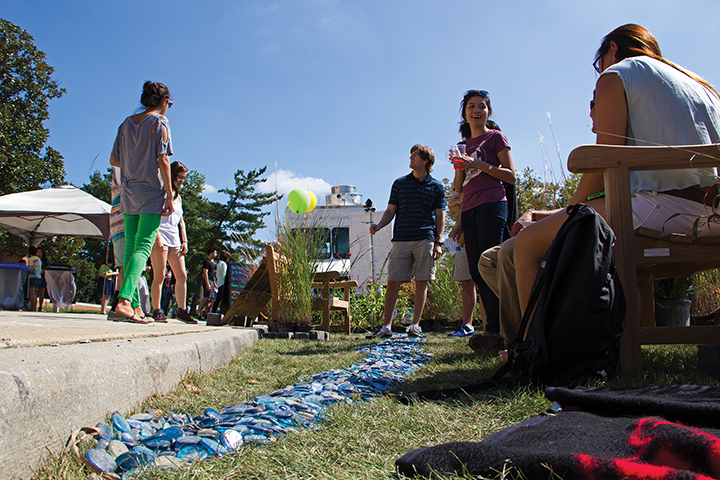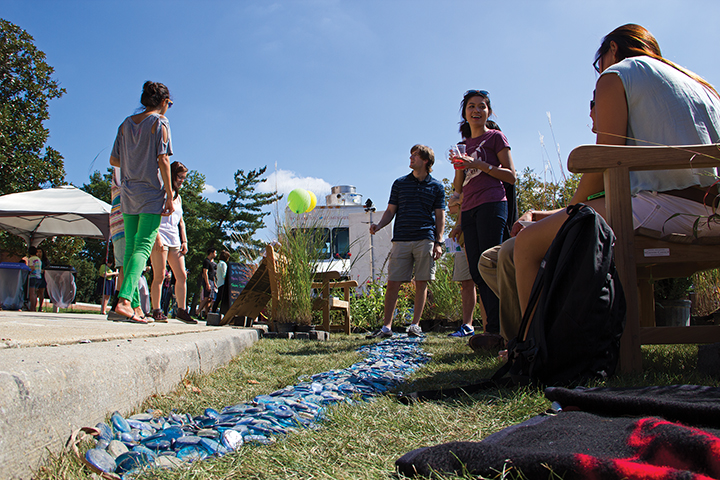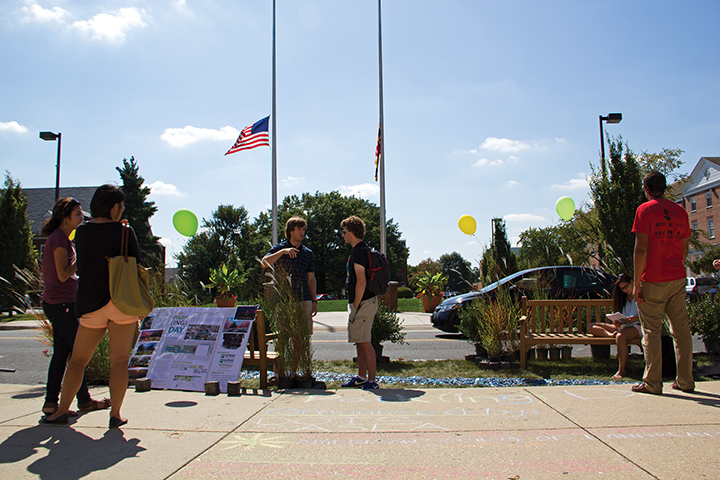On Friday, a group of students put the “park” in “parking.”
In celebration of the international environmental movement “PARK(ing) Day,” this university’s chapter of the American Society of Landscape Architects and the UMD Arboretum and Botanical Garden converted two parking spaces in front of Cole Field House into a public park. Every Sept. 20 since the movement began in San Francisco in 2005, artists, architects, landscapers and others create temporary public parks out of metered parking spaces.
“It’s a display of, ‘Here’s what could happen,’” said Anna delos Angeles, a senior landscape architecture major involved in ASLA. “Just seeing what could be done with this amount of space.”
The goal of the movement is to raise awareness of the importance of open, green spaces in urban places and make people smile for a day, according to the event’s website. Since its conception, the event has spread around the world: As of 2011, supporters had created 975 “parks” in 162 cities in
35 countries on six continents.
At this university, ASLA students started planning the event before the semester started, obtaining permission from the Department of Transportation Services to use two parking spaces for the day. They designed a park plan for the small space and received a donation of landscaping materials from Ruppert Landscape, a local company based in Laytonsville, delos Angeles said.
Friday at 7 a.m., the students and Ruppert Landscape workers started setting up their park outside Cole Field House. Setup took two hours, said Taylor Becker, a senior landscape architecture major and ASLA member.
“The setup and the event couldn’t have gone any smoother,” Becker said. “We were fortunate to have such great weather, as well.”
On Friday, students passing Cole Field House saw a patch of short, green grass against the familiar asphalt. Benches lined a blue pebble “stream” amid sections of tall grass and plants. Students gathered in the area, talking to the ASLA students and one another as they relaxed on benches and ate food from the Green Tidings food truck, which DOTS had scheduled to come by the event.
“I’m excited to see that our group here took it upon themselves [to create the park],” Becker said, adding he hoped the park would be a “cool place to hang out” for the day.
More than 200 students stopped by between 10 a.m. and 4 p.m. to see the park, relax and learn about PARK(ing) Day, Becker said.
“I think the event was a great success. The event allowed people to see an example of an alternative to traditional parking spaces in cities,” he said, adding it got the attention of the Office of Sustainability and other university organizations.
It was “an opportunity to educate others on what we do as landscape architects, as well as get involved in [the] school community,” Becker said.
At about midday on Friday, DOTS Director David Allen stopped by for what was supposed to be a two-hour “Sound Your Horn!” forum-style event to answer questions about parking and transportation on the campus. Each year, DOTS hosts about three or four of these events to “get input from students about their parking and transportation experiences on campus,” Allen said.
The informational event was scheduled to be part of PARK(ing) Day festivities, but Allen cut the event short after 45 minutes, feeling it was not the “right venue.”
“It was more of the students’ day,” Allen said, adding he wanted the day to be more about ASLA students’ work designing the park than about DOTS. There will be other opportunities this year, at more appropriate times, for students and faculty to voice their concerns to DOTS, Allen said.
In the future, ASLA hopes to continue the event, using more parking spaces and including other campus organizations, Becker said. To him, PARK(ing) Day is an important demonstration of the significance of parks in urban places and cities.
“Parks offer many benefits for the environment as well as human health,” he said.
American Society of Landscape Architects members hoped to raise awareness of the importance of maintaining open green spaces in urban areas by converting two metered parking spaces in front of Cole Field House into a temporary public park.





